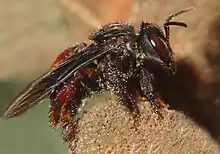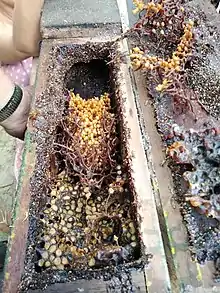Trigona
Trigona is one of the largest genera of stingless bees, comprising about 32 species,[1] exclusively occurring in the New World, and formerly including many more subgenera than the present assemblage; many of these former subgenera have been elevated to generic status.[2]
| Trigona | |
|---|---|
 | |
| Trigona spinipes | |
| Scientific classification | |
| Domain: | Eukaryota |
| Kingdom: | Animalia |
| Phylum: | Arthropoda |
| Class: | Insecta |
| Order: | Hymenoptera |
| Family: | Apidae |
| Tribe: | Meliponini |
| Genus: | Trigona Jurine, 1807 |
| Subgenera | |
|
Duckeola | |
_Flores.jpg.webp)
Range
Trigona species occur throughout the Neotropical region, including South and Central America, the Mexican lowlands, and the Caribbean islands. They can occur in forests, savannas, and man made environments. Trigona bees are active all year round, although they are less active in cool environments.[2]

Nesting
Trigona nests are constructed from wax they produce and plant resins they collect. They usually nest in tree cavities and underground.[1][2][3]
Vulture bees
Vulture bees comprise three Trigona species, and are the only bees known to be scavengers. These bees collect and feed on dead animal flesh.
Communication
Some species of Trigona bees use saliva to lay scent trails guiding nest mates to a food source.[4] Some species of Trigona use eavesdropping which help them detect food sources being exploited by competitors.[5]
Selected species
- Trigona branneri—Mato Grosso (Brazil)[6]
- Trigona chanchamayoensis—Mato Grosso (Brazil)[6]
- Trigona cilipes—Americas
- Trigona corvina - Central and South America[7]
- Trigona crassipes (Fabricius, 1793)
- Trigona ferricauda—Americas
- Trigona fulviventris—Mexico to Colombia
- Trigona fuscipennis—Mexico to Brasil.[8]
- Trigona hyalinata—Mato Grosso (Brazil)[6]
- Trigona hypogea (Silvestri, 1902)
- Trigona necrophaga (Camargo & Roubik, 1991)
- Trigona nigerrima—Americas (Mexico, Costa Rica)
- Trigona nigra—Mexico
- Trigona pallens—Americas
- Trigona recursa—Mato Grosso (Brazil)[6][8]
- Trigona silvestriana—Americas (Costa Rica)
- Trigona spinipes—arapuá (Brazil)[9]
References
- Grüter, Christoph (2020). Stingless Bees: Their Behaviour, Ecology and Evolution. Fascinating Life Sciences. Springer New York. doi:10.1007/978-3-030-60090-7. ISBN 978-3-030-60089-1. S2CID 227250633.
- Michener, C.D. (2000). The Bees of the World. Johns Hopkins University Press
- Roubik, D W. (2006). "Stingless bee nesting biology". Apidologie. 37 (2): 124–143. doi:10.1051/apido:2006026.
- Schorkopf, Dirk Louis P.; Jarau, Stefan; Francke, Wittko; Twele, Robert; Zucchi, Ronaldo; Hrncir, Michael; Schmidt, Veronika M.; Ayasse, Manfred; Barth, Friedrich G. (2007-03-22). "Spitting out information: Trigona bees deposit saliva to signal resource locations". Proceedings of the Royal Society of London B: Biological Sciences. 274 (1611): 895–899. doi:10.1098/rspb.2006.3766. ISSN 0962-8452. PMC 2093984. PMID 17251108.
- Nieh, James C.; Barreto, Lillian S.; Contrera, Felipe A. L.; Imperatriz–Fonseca, Vera L. (2004-08-07). "Olfactory eavesdropping by a competitively foraging stingless bee, Trigona spinipes". Proceedings of the Royal Society of London B: Biological Sciences. 271 (1548): 1633–1640. doi:10.1098/rspb.2004.2717. ISSN 0962-8452. PMC 1691773. PMID 15306311.
- Kleber França Costa; Rute Magalhães Brito; Carlos Suetoshi Miyazawa (2004). "Karyotypic description of four species of Trigona (Jurine, 1807) (Hymenoptera, Apidae, Meliponini) from the State of Mato Grosso, Brazil" (PDF). Genetics and Molecular Biology. 27 (2): 187–190. doi:10.1590/s1415-47572004000200010.
- Michener, Charles D. (1946-09-01). "Notes on the Habits of Some Panamanian Stingless Bees (Hymenoptera, Apidae)". Journal of the New York Entomological Society. 54 (3): 179–197. JSTOR 25005167.
- Tarelho* Trigona fulviventris—Mexico, Z. V. S. (1973). Contribuição ao estudo citogenético dos Apoidea (masters thesis). University of São Paulo, Ribeirão Preto.
- Brito and Pompolo (1997). "C:G patterns and fluorochrome staining with DAPI and CMA3, in Trigona spinipes (Jurine, 1807) (Hymenoptera, Apidae, Meliponinae)". Brazilian Journal of Genetics.